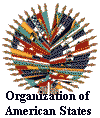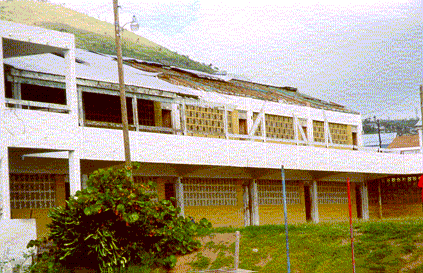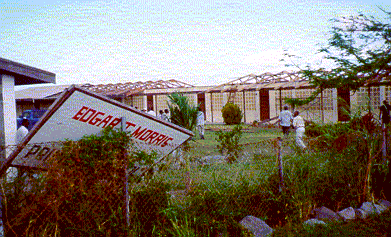Caribbean Disaster
Mitigation Project
Implemented by the Organization of American States
Unit of Sustainable Development and Environment
for the USAID Office of Foreign Disaster Assistance and the Caribbean Regional Program
The Natural Hazards Project component was
financed by the European Community Humanitarian Office (ECHO)
OAS-ECHO School Vulnerability Reduction Program |
 

|
CDMP Progress Bulletin
School/Shelter Hazard Vulnerability Reduction in the Eastern Caribbean
Bulletin Date: December 1999
Countries in the Eastern Caribbean are subject to a multitude of natural hazards,
including floods, hurricanes, earthquakes, landslides and volcanoes. Availability of
adequate and safe shelters during or after hazardous events can limit the loss of life and
injury resulting from those events. In designating shelters for protection from natural
hazards, it is critical that the selected buildings be located away from high-hazard areas
and able to withstand the stresses placed upon them by high winds, rain, water and ground
shaking. The Caribbean Disaster Mitigation Project (CDMP) and the Natural Hazards Project
(NHP) of the Organization of American States have been working jointly since September
1997 to strengthen the network of emergency shelters and school buildings, which are often
used as emergency shelters. The countries involved in this project include Anguilla,
Antigua and Barbuda, Dominica, Grenada and St. Kitts & Nevis. (See photos of selected schools from these countries.)
This project contains two primary components: a survey of currently designated shelters
and training for the education sector in hazard mitigation for schools.
Shelter Survey
The shelter survey is composed of three stages. A preliminary assessment and screening
of 86 properties (20 per country, 6 in Anguilla) was conducted by local engineers to
classify the properties with respect to their retrofit needs. Standards for retrofitting
these structures, and for constructing new schools and shelters, are currently being
developed to guide the retrofit work and future construction. Based on the screening and
the retrofit guidelines, global estimates of retrofitting costs for each of the classes of
properties will be developed.
To support the preliminary screening, CDMP/NHP prepared a survey form to be used by
local engineers in assessing the selected properties. This form has three parts: seismic hazard survey part I, seismic hazard survey part II and a wind hazard survey. Local engineers were trained
in the application of this form. This survey addresses both wind and earthquake
resistance. Based on the completed survey forms and follow-up site visits, CDMP/NHP will
develop terms of reference for engineering work required to retrofit these buildings to a
hazard-resistant state. The actual retrofit work will be financed with loan funding from
the Caribbean Development Bank (CDB) as a follow-up activity to this project.
Final products of this project component include:
Training
Recognizing that the majority of the properties identified in the survey component of
the project were schools, the CDMP joined forces with NHP and implemented a school
vulnerability reduction campaign in countries affected by Hurricanes Luis and Marilyn:
Antigua and Barbuda, Dominica, and St. Kitts. As part of this effort, two series of
national workshops were held in Antigua, Dominica and St. Kitts in January and March of
1998 for organizations and individuals involved in school building design, construction,
reconstruction, retrofitting, and maintenance. Participants included officials from
government ministries, non-governmental organizations, community organizations, private
sector engineers/architects and volunteer groups.
The workshops focused on those aspects of the planning process relating to natural
hazard vulnerability and risk mitigation, especially in the pre-feasibility stages. The
workshops served as a forum to discuss and draft policies to reduce vulnerability as well
as look at preparedness and emergency response activities. These workshops were
instrumental in helping the governments of Antigua and
Barbuda, Dominica and St. Kitts & Nevis to design national school
vulnerability reduction plans. These national plans are to be presented before the
respective cabinets for approval and adoption.
In the Eastern Caribbean, school building maintenance is critical to ensuring that
hazard-resistant buildings remain safe. For this reason, the OAS developed a school building maintenance manual for use in
the Caribbean. The manual is intended for use by non-technical school personnel such as
school principals and teachers. Country specific maintenance manuals were developed for
Antigua and Barbuda, Dominica, and St. Kitts & Nevis.
Regional Workshop
 A regional workshop was
held October 14-15, 1998, in Basseterre, St. Kitts to review the findings of the
engineering study mentioned above and to discuss school/shelter maintenance and the role
of the community. Additional discussion focused on CDB loan financing for the retrofit
work recommended. The themes of the workshop were quite timely since Hurricane Georges had
recently passed through the Caribbean and left a mark on the schools and shelters in St.
Kitts & Nevis as well as in Antigua and Barbuda. Representatives from the Ministries
of Education, Public Works, and the Disaster Preparedness Offices from Anguilla, Antigua
and Barbuda, Belize, Dominica, Grenada, St. Kitts & Nevis, St. Lucia, and Trinidad as
well as representatives from CDB, the Caribbean Disaster Emergency Response Agency
(CDERA), Partners of the Americas, and the US Peace Corps were in attendance. (See workshop participant list.)
A regional workshop was
held October 14-15, 1998, in Basseterre, St. Kitts to review the findings of the
engineering study mentioned above and to discuss school/shelter maintenance and the role
of the community. Additional discussion focused on CDB loan financing for the retrofit
work recommended. The themes of the workshop were quite timely since Hurricane Georges had
recently passed through the Caribbean and left a mark on the schools and shelters in St.
Kitts & Nevis as well as in Antigua and Barbuda. Representatives from the Ministries
of Education, Public Works, and the Disaster Preparedness Offices from Anguilla, Antigua
and Barbuda, Belize, Dominica, Grenada, St. Kitts & Nevis, St. Lucia, and Trinidad as
well as representatives from CDB, the Caribbean Disaster Emergency Response Agency
(CDERA), Partners of the Americas, and the US Peace Corps were in attendance. (See workshop participant list.)
Workshop Objectives
- To review the findings of the engineering study that analyzed the vulnerability of 86
schools/shelters in five countries to wind and seismic hazards.
- To present and discuss standards for retrofitting existing schools/shelters and for the
construction of new ones.
- To discuss the steps involved in obtaining loan financing from the CDB to retrofit the
buildings included in the study.
- To discuss retrofit programs in the context of comprehensive school/shelter building
vulnerability reduction.
Key Points
- New legislation is not needed to ensure that school/shelter buildings are constructed
properly, the challenge lies in enforcement of existing codes and political will.
- Full support from the government and commitment to rebuild to higher more hurricane
resistant standards is crucial.
- Lending institutions have a responsibility to ensure that loan funds will be applied to
safe construction. It is irresponsible to lend money to rebuild if buildings will be
constructed without consideration for vulnerability reduction.
- Maintenance of school/shelter buildings is imperative and the responsibility must be
assigned to those that have a vested interest in the condition of the buildings.
- Ideally, school buildings should not be used as shelters; however, with proper
management they can serve this dual purpose. A presentation on this topic, as it relates
to Dominica, was presented by Vivian Trotter at the
1999 National Hurricane Conference.
- More public education is needed to garner support for hazard mitigation. The consumer
needs to be educated about vulnerability reduction; it should not be left solely to the
discretion of designers and construction companies to make decisions.
- Even if a school building is not going to serve as a shelter, it should be built to
withstand the hazards that threaten it because of its important role in the community and
the education of children.
Basseterre Junior High School,
Post-hurricane Georges

|
Edgar T. Morris Primary School (St.
Kitts), Post-hurricane Georges

|
Site visits to school/shelter buildings damaged by Hurricane Georges were the highlight
of the workshop. Unfortunately, it was evident that reconstruction was taking place
without consideration or adherence to recommended building codes or standards. For
example, when asked why metal sheeting of an insufficient weight was being put on roofs,
the response was that only that particular grade was being imported. Repairs to the school
buildings could not be put on hold until proper materials were secured, services needed to
be restored quickly. It was said that these repairs were only temporary. When asked what
"temporary" meant, it was said jokingly, at least until the next hurricane.
Final Products
The Next Steps
The consensus of the workshop was that the cycle of "quick fixes" after a
disaster must be broken. The five countries involved in the project agreed to seek loan
funding from the CDB to finance systematic retrofitting
and improved maintenance of schools and other public buildings used as shelters in
disasters.
The CDB for its part offered to assign a consultant to work with each country on the
preparation of a detailed loan request, once the countries submit formal applications for
loans. With resources from the Caribbean Disaster Mitigation Project and in collaboration
with other donor agencies, the OAS will continue to support the participant countries in
their efforts to introduce national school vulnerability reduction programs and in
obtaining financing for the implementation of school/shelter vulnerability reduction.
For additional information on vulnerability reduction in the education sector, see the School/Shelter Hazard Vulnerability Reduction Resource Page.
The Caribbean Disaster Mitigation Project (CDMP) is a coordinated
effort to promote the adoption of natural hazard mitigation and preparedness practices by
both the public and private sectors in the Caribbean region. The CDMP is funded by the
USAID Office of Foreign Disaster Assistance (OFDA) and implemented by the Organization of
American States/Unit of Sustainable Development and Environment (OAS/USDE) for the
Caribbean Regional Program (USAID/CRP).
The NHP, with financial support from ECHO, is providing technical
assistance to help prepare disaster reduction programs to protect school infrastructure
through technical assistance, training, technology transfer and by supporting the
formulation of policy and strategic action plans for the education sector.



 A regional workshop was
held October 14-15, 1998, in Basseterre, St. Kitts to review the findings of the
engineering study mentioned above and to discuss school/shelter maintenance and the role
of the community. Additional discussion focused on CDB loan financing for the retrofit
work recommended. The themes of the workshop were quite timely since Hurricane Georges had
recently passed through the Caribbean and left a mark on the schools and shelters in St.
Kitts & Nevis as well as in Antigua and Barbuda. Representatives from the Ministries
of Education, Public Works, and the Disaster Preparedness Offices from Anguilla, Antigua
and Barbuda, Belize, Dominica, Grenada, St. Kitts & Nevis, St. Lucia, and Trinidad as
well as representatives from CDB, the Caribbean Disaster Emergency Response Agency
(CDERA), Partners of the Americas, and the US Peace Corps were in attendance. (See
A regional workshop was
held October 14-15, 1998, in Basseterre, St. Kitts to review the findings of the
engineering study mentioned above and to discuss school/shelter maintenance and the role
of the community. Additional discussion focused on CDB loan financing for the retrofit
work recommended. The themes of the workshop were quite timely since Hurricane Georges had
recently passed through the Caribbean and left a mark on the schools and shelters in St.
Kitts & Nevis as well as in Antigua and Barbuda. Representatives from the Ministries
of Education, Public Works, and the Disaster Preparedness Offices from Anguilla, Antigua
and Barbuda, Belize, Dominica, Grenada, St. Kitts & Nevis, St. Lucia, and Trinidad as
well as representatives from CDB, the Caribbean Disaster Emergency Response Agency
(CDERA), Partners of the Americas, and the US Peace Corps were in attendance. (See 
